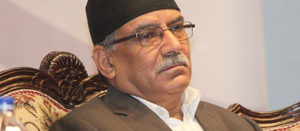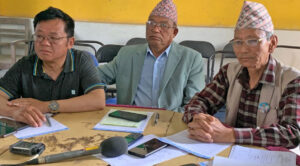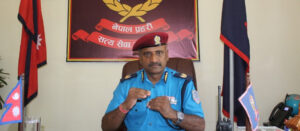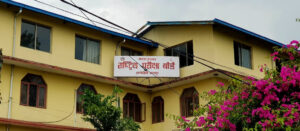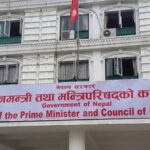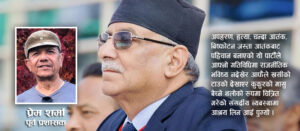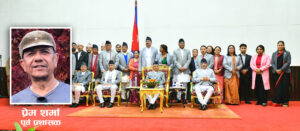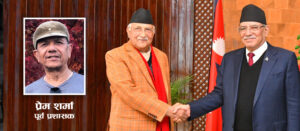
Dysphagia: The Disorder of Swallowing
Swallowing disorders are very common in Nepalese society. These are the conditions that are reported by many people in Nepal, but still,rehabilitation of these issues is not sought in many of the cases. The disorders of swallowing refer to the conditions where there is a difficulty or inconvenience in the process of taking the food from the oral cavity to the digestive tract, or, in other words, to swallow the food. This condition is termed as “Dysphagia”.It can be oropharyngeal type (problems in swallowing due to the issues in oral and pharyngeal structures) or esophageal type (because of anomalies in structure and function of the esophagus), and in this article, we shall focus more upon the causes, evaluation, and management of oropharyngeal dysphagia.
We do not pay attention to the normal phenomenon of how we use our fine motor skills to prepare the food bolus with cutlery or hands and then direct towards our mouth. The food then reaches to a cavity, surrounded by teeth, with a mobile tongue where it gets ground by the teeth, mixed with saliva. The lips have to get sealed during such a process, and the tongue mobilizes the prepared food bolus within the cavity. Meanwhile, the feedback mechanism ensures the positioning of the food bolus as well as that the tongue is not injured while chewing. When the pressure of the tongue against the palate increases, the soft palate is elevated against the posterior pharyngeal wall, and food passes to the pharynx; the nasopharynx is sealed to prevent reflux in that phase. After that, the pharyngeal phase occurs as it reaches the pharynx where the larynx (the voice box) gets closed by epiglottis and gets elevated along the hyoid bone, along with the actions of tongue base and pharyngeal walls. The pharyngeal phase is succeeded by the esophageal phase, where the food enters the esophagus by the opening of the upper esophageal sphincter, transits through the esophagus, and again reaches the stomach after the lower esophageal sphincter opens.There is also a torturous process of involvement of the nervous system during this entire process. This is how the normal process of swallowing of the food takes place, of which the complexity we do not even think upon; nevertheless, when even a slight difficulty occurs in between such process and the goal is not achieved, we start thinking of the problem and realize how intricate it is.
Dysphagia is one of the very few discussed medical terms among the public, in health magazines, social media, health forums, public health awareness programs, etc. especially in the context of Nepal. That might be one reason why the Nepalese are not able to give a frame and be vocal regarding their difficulty in swallowing. It is a serious problem becauseif one is not able to intake food, conditions likethe nutritional deficit, energy deficit, psycho-emotional issues, social issues, dependency on others, etc. can occur. Even in children, proper physical and intellectual growth will be hindered if there are issues in feeding. Therefore, considering all these consequences, it is very important for the public to be aware of this problem and for them to address the problem.
Swallowing disorders are associated with several conditions—neurogenic, age-related, congenital, structural, behavioral, iatrogenic, etc. The neurogenic conditions that involve the nerve fibers or neuromuscular junctions are Alzheimer’s disease, Parkinson’s disease, Amylotropic Lateral Sclerosis, Multiple Sclerosis, Myasthenia Gravis etc. Even the traumatic brain injuries, stroke, head and neck cancer, brain tumors, etc. can result in dysphagia. It is also reported in some syndromes like Down syndrome, PraderWilli syndrome, Rett syndrome, and many more. The problems in feeding can also arise in children with cleft lip and palate as well as those with cerebral palsy. Moreover, lots of structural anomalies of oropharyngeal, respiratory, and gastrointestinal structures may also result in dysphagia, and difficulties in swallowing may also be caused due to the side effects of different medications as well as because of endocrine dysfunction, metabolic disorders, and inflammations and infections of the structures responsiblefor aiding in swallowing. Gastroesophageal reflux disease is one of the very common causes of dysphagia that progressively affects the lower esophageal sphincter and then the surface of the esophagus itself. Thus, the disorders of swallowing are associated with different etiologies, and appropriate investigation of the cause is very necessary for the management of it.
There is a role of a team of medical professionals in the investigations and detailed assessment of dysphagia, which mainly includes a medical speech-language pathologist, ENT specialist, gastroenterologist, occupational therapist, nutritionist, nurse, and radiologist. First of all, in a hospital set up, when a patient reports a problem in swallowing, he or she is primarily attended by a speech-language pathologist (SLP): the specialist of disorders of communication and swallowing. SLPs work on different hospitals, clinics, rehabilitation centers, and institutes to provide health services. Even in our country Nepal, SLPs have started providing the services related to swallowing disorders along with a team of other professionals in different hospitals. Inthe case of the evaluation of dysphagia, SLP performs bedside screening test first to rule out where the problem has been in or the type of swallowing disorder. The screening helps examine the functioning of oral structures, the extent of compatibility of any specific type and texture of food to intake, aspiration, or any discomfort during the process. Furthermore, different associated factors like dentition, pulmonary function, posture, neurological issues, oro-pharyngeal anomalies, etc. have to be investigated in detail by the respective medical professionals. Then the speech-language pathologist compiles and interrelates the findings.
Apart from different test batteries, subjective evaluations, and screening tests, it is equally important to carry out a set of objective tests or instrumental evaluations in order to probe on the swallowing related problems. For the assessment of oro-pharyngeal dysphagia, there are two very important tests, often regarded as diagnostic tests of dysphagia—Flexible Endoscopic Evaluation of Swallowing (FEES) and Videofluoroscopy (Modified Barium Swallow Study). FEES involves the procedure that uses a fibreopticnaso-endoscope, which is inserted through the nasal cavity, passed to the pharynx, and helps in inspecting the anatomical structures till laryngopharynx including vocal folds while swallowing. This helps to rule out the anomalies in the structures, management of secretions, risk of aspiration, as well as swallow fatigue over time. The latter one, namely videofluoroscopy, can be used both in the assessment of oropharyngeal movement of food bolus as well as observation of the esophageal region during swallowing. The food mixed with barium is given to the person to be tested and is scanned through the fluoroscopic planes.The time taken for the bolus to transit to different stages, duration of total swallow, the opening of the upper sphincter of the esophagus, the direction of the movement of bolus, aspiration, and spillage of food can be primarily evaluated by videofluoroscopy. Another procedure through which, the investigator can roughly predict the normal or disordered swallow is the cervical auscultaion. Using a stethoscope, the investigator listens to the sound produced during swallowing and judge if that seems wet sound or airway turbulence, which could be due to aspiration into the airway or penetration in the laryngeal structures.The cervical auscultation can also be used using standard equipment where the swallow sounds are acoustically analyzed. Similarly, there are many other instruments like ultrasonography, oro-pharyngeal esophageal scintigraphy, surface electromyography, and many more. Since Nepal is still fledging in terms of advanced medical instruments, we hope these objective evaluations will be started for swallowing disorders in the near future; nevertheless, few hospitals of Nepal have been carrying out FEES for the evaluation of persons with swallowing disorders.
The management of dysphagia is always a team approach involving an interdisciplinary team, where the team members discuss their treatment goals and outcomes among themselves. In the cases, which require the medical, surgical, and pharmacological management options, the team of doctors, including gastroenterologists, otolaryngologists, pulmonologists, and other medical and surgical actively work for the management. Different feeding options other than oral feeding like nasogastric tubes, percutaneous endoscopic gastrostomy tube, etc. may be required as per the types of disorders.
In contrast, there are other cases of swallowing disorders, which can be managed through some sort of diet modifications and behavioral management approaches. A speech-language pathologist, the primary team member for non-surgical and non-pharmacological rehabilitation, is actively involved in such approaches, where the goals of treatment will be to strengthen and enhance the functioning of the oro-pharyngeal structures responsible for swallowing. They work to sensitize the oral structures, promote proper lip seal, enhance the range of motion of the tongue, enhance the strength of the oral musculature, promote appropriate functioning of the laryngeal structures, etc. An SLP also carries out the compensatory or the direct approaches which involve different types of swallow maneuvers like Super Supraglottic swallow, Mendelson Maneuver, etc., and postural modification strategies like head tilt, chin down, etc. to be carried out at the time of swallow. The SLP is supposed to be there during the instrumental evaluations like FEES or videofluoroscopy, and on the basis of the inspection, the impression regarding the pathology on the swallowing process, the treatment approach is formulated. For example, for the spillage in valleculae or pyriform sinus, a particular approach is there, and if the laryngeal elevation is not appropriate, some other approach is there. Moreover, the exercises are designed specifically for the particular phase of swallowing, be it the oral phase or pharyngeal phase, targeting the particular functions of specific structures involved.
Another very important aspect in the management of dysphagia is diet modification; the team involving SLP, dietician, occupational therapist, and caregiver has a very important role in this. The diets are categorized into different levels on the basis of viscosity and texture, not neglecting the nutritional aspect, and are planned accordingly to give to the persons with dysphagia. Furthermore, an SLP often uses different instruments in the treatment of dysphagia like Neuromuscular Electrical Stimulation (NMES), expiratory muscle training instruments, thermal-tactile stimulation equipment, etc. Such rehabilitation services are being carried out in very few hospitals in Nepal by qualified and competent speech-language pathologists, and they agree that the increased awareness regarding this type of behavioral approach among other health professionals would really help patients struggling with their problems to take food get evidence-based rehabilitation.
To summarize, the difficulties in swallowing has been more often heard, and experienced cases in our society, which are seldom reported to the related professionals inasmuch very few are aware that the management of this can be done. It can occur secondary to any disorders or could be the harbinger of any covert anomaly. In the context of Nepal, there are very few places where the management of dysphagia is kept under significant consideration, with an appropriate management team. Generally, the treatment approaches of dysphagia other than surgical, pharmacological, and medical management, have been in the shade, and the patients are not referred much in Nepal for the behavioral treatment approaches and swallow therapies to speech-language pathologists. This could be because it is recent that these professionals have started providing services to persons with disorders of swallowing. If medical professionals are well aware of the referral of dysphagia cases to the appropriate professionals, our nation will have a dynamic change in the field of swallowing disorders. Furthermore, for this change, our society must give importance to their problems with swallowing just like other health issues, and report to the concerned professionals in time not assuming it as a secondary problem.


